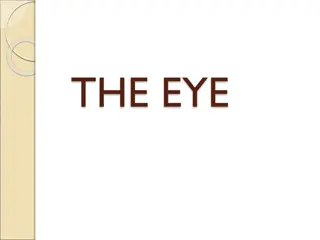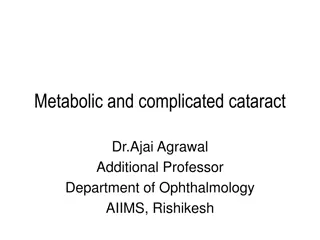What is #ScienceSaves?
The #ScienceSaves campaign promotes the impact of science on improving lives and health. Dr. Patricia Bath, a renowned ophthalmologist, contributed greatly to eye health by innovating eye surgery techniques, ultimately preventing blindness. Explore the fascinating world of the human eye, its structu
0 views • 15 slides
Understanding Astigmatism and Its Types
Astigmatism is a common refractive error where light entering the eye fails to focus on the retina, resulting in blurred vision. This condition is characterized by variations in the shape of the cornea or lens, leading to disturbances in vision. There are two types of astigmatism: regular and irregu
4 views • 33 slides
Understanding New Jersey Mature Driver Challenges
New Jersey has a significant population of mature drivers aged 65 and older, accounting for 21% of licensed drivers. The proportion of crashes involving mature drivers has increased, with over 17% occurring in 2020. Vision, hearing, cognition, and physical condition changes with aging impact driving
0 views • 51 slides
Understanding Eye Health: From Anatomy to Treatment of Common Eye Conditions
Explore the anatomy of the eye, learn about common eye diseases like corneal laceration and cataracts, and understand their treatments. Discover the impact of cataracts on global blindness and the surgical options available for restoring vision. Follow a martial arts athlete's journey through cornea
0 views • 13 slides
Understanding Cataracts: Causes, Effects, and Treatment
Cataract is a common eye condition characterized by clouding of the lens, leading to gradual vision loss. It is the third leading cause of preventable blindness and is typically treated with surgery. Various factors, such as aging, trauma, and toxic exposures, contribute to the development of catara
0 views • 34 slides
Understanding Metabolic and Complicated Cataracts: Classification and Subtypes
Explore the etiological classification of cataracts, focusing on metabolic and complicated types such as diabetic cataracts, galactosemia-related cataracts, myotonic dystrophy-related cataracts, and hypocalcaemic cataracts. Learn about distinct morphological subtypes, pathophysiology, and specific c
0 views • 31 slides
Understanding Myopia Control for Optometrists
Myopia, or nearsightedness, is a growing concern with increasing prevalence, especially among younger populations in Asia. Genetics, environmental factors like prolonged digital device use, and lack of outdoor activities contribute to its development. Controlling myopia is crucial to prevent risks l
0 views • 23 slides
Understanding Cataracts: Types, Causes, and Classification
Cataracts are characterized by lens opacity and can result from various factors like aging, trauma, or congenital issues. They are classified based on etiology and morphology, with distinct clinical types presenting different symptoms and characteristics.
0 views • 48 slides
National Programme for Control of Blindness & Visual Impairment Overview
The National Programme for Control of Blindness & Visual Impairment (NPCBVI) is a government initiative aimed at reducing the prevalence of avoidable blindness in India. Launched in 1976, the program focuses on providing comprehensive eye care services, developing human resources, enhancing communit
9 views • 15 slides








